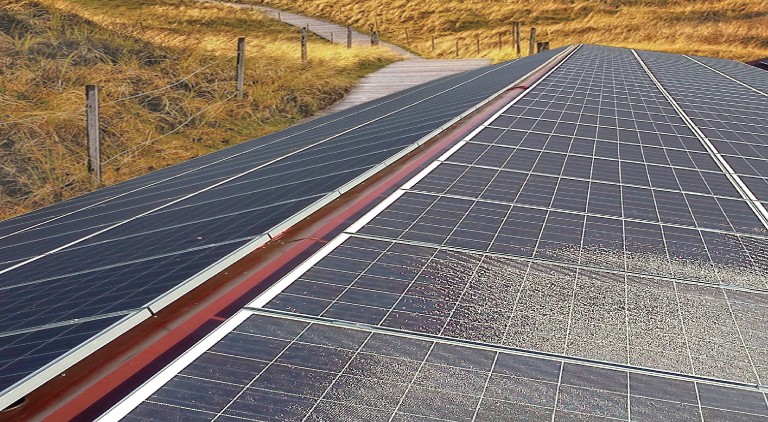Low cost solar PV module for solar proliferation
April 5, 2019 3:48 pm
April 5, 2019 3:48 pm

An analysis on why the cost of PV modules is dropping drastically and high efficiency cells and improved technologies will swallow up the whole market as the demand of the solar power is increasing day to day.
PV industry has witnessed nearly 90 per cent fall in module costs from 2006 to 2018. There are various causes that have led to consistent fall in solar PV module costs, the primary reason appears to be their macro-economic nature driven by periodic cycles of oversupply and high demand.
Cost of PV modules is dropping drastically
The urgency created by the need for energy security and climate crisis, fuelled decisions worldwide to opt for green energy. As the demand continued to rise, countries like China set about building humongous manufacturing capacities of solar PV modules. This attempt triggered high quality technological growth in the solar industry. Setting up manufacturing industries and supporting solar technological growth also aided in job creation and economic stability within a country, thus becoming a sustainable circle.
Ivan Saha, BU head of Solar Manufacturing and CTO, Vikram Solar says, “Enhanced manufacturing capacities created an oversupply of PV modules in emerging solar markets in the world and the ensuing competition between entities trying to supply and sell solar PV modules, facilitated a consistent fall in solar module price over past several years.”
Another reason for the cost decline are the rapid technological advances that have been made in the PV industry, as soon as the size of the market started to increase exponentially. The factories producing solar modules, cells and wafers achieved economies of scale once they crossed the Gigawatt barrier. Manufacturing machines became faster, material consumption reduced and conversion costs plummeted as large factories quickly ascended the learning curve. Saha says, “Cumulative impacts of market pressure and technological achievement have made product cost competitiveness a key element of survival strategy.”
Krishnendu Mukherjee, CEO, Sova Solar states that as competitive market prevails in India for solar module, there is also a possibility for a drop in price for the solar equipment. Though the demand of solar electrification is increasing in India, the competition among the companies remains the same in the market, which in turn will decrease the cost over time. Besides this, it is also said that the decline of the falling price is driven by the reforms in the solar industry in China.
Improving technology
It is expected that high efficiency cells and improved technologies will swallow up the whole market as the demand of the solar power is increasing day to day. New technologies and manufacturing methods have drastically improved efficiency and higher efficiency have lowered the costs of the production over the year. India and other developing countries are the biggest beneficiaries of this trend. Mukherjee says, “The higher efficiency mono crystalline modules are expensive but it is expected that in next few years the availability of these will decreases the cost of the modules. “
Saha says, “It is important to note that consistently falling solar PV cost has severely impacted the quality and cost of downstream project bidding in emerging solar markets by pushing bidders to compete at very low profit margins.” For example, we can highlight that, riding on a steep fall of equipment prices, the Indian solar energy cost has fallen from `12 per kWh in 2010 to `2.62 per kWh in 2018. This is again circa 90 per cent fall which drives further solar proliferation, which is good news. The bad news is that it also creates two issues – shrinking ROI for investors and compromises on quality of PV modules to maintain sustainability of downstream developers, both impacts the sector’s credibility.
Practices to select PV modules
“In India, solar panel with maximum system voltage of 1500 volt has already been introduced which increases power density and performance of the solar PV module. It will reduce the losses in DC cables, reducing capital costs, susceptibility to PID increases. It is expected that in the next 5 years 1500V system would see an increased market penetration around 95 per cent,” says Mukherjee. As a free source of energy, solar PV modules is to become the trend of renewable energy due to their higher efficiency in electricity generation.
Selecting high performance and high efficiency solar panels are the deciding factors of a solar plant’s reliability, assures Saha.
• Making sure that the PV modules are higher than 16 per cent efficiency for polycrystalline silicon modules and 17.5 per cent efficiency for monocrystalline modules
• Ensure SPV modules are certified according to the relevant IEC standards for Type testing (IEC 61215) and Safety (IEC 61730).
• Ensure that the specified Bill of Materials are as per the Type testing standard CDF
• Making sure that the modules are certified for saltmist, ammonia corrosionand potential induced degradation in the specific application scenarios.
• Silicon modules are manufactured according to standard manufacturing practices and as per an industry standard ‘Module Quality Protocol’ (MQP)
• Extended reliability testing are carried out from a reputed third party laboratory like DNVGL or PVEL
• Making sure that the modules come with 25 years or higher power output warranty and more than 10 years of manufacturing warranty.
• Checking the manufacturer’s portfolio to make sure that they have conservative client list in national and global markets and have been in business have more than a half a decade.
Cumulative impacts of market pressure and technological achievement have made product cost competitiveness a key element of survival strategy.
Ivan Saha, BU head of Solar Manufacturing and CTO, Vikram Solar
New technologies and manufacturing methods have drastically improved efficiency and higher efficiency lowers the costs of the production.
Krishnendu Mukherjee, CEO, Sova Solar
We use cookies to personalize your experience. By continuing to visit this website you agree to our Terms & Conditions, Privacy Policy and Cookie Policy.